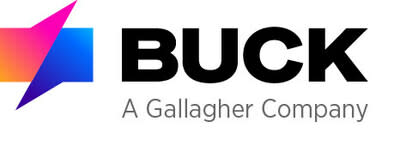Medical costs for employer-sponsored plans continue to outpace inflation due to advances in treatments and industry consolidation trends according to Buck survey
NEW YORK, Dec. 12, 2023 /PRNewswire/ -- Greater use of diagnostic testing and advances in medical technology and treatments are among the factors pushing medical trends higher than the rate of inflation, according the 45th National Healthcare Trend Survey, published by Buck, a Gallagher company, an integrated HR, pensions, and benefits consulting, technology, and administration services firm. The company has been monitoring medical trend factors used by health insurers and third-party administrations to project employers' future healthcare costs since 1999.
The survey of nearly 100 health insurers and health plan administrators covering more than 100 million plan participants predicts even higher medical trend factors in the future due to providers renegotiating higher fees with insurers, as well as other changes occurring in the healthcare industry. Compared to the prior survey released in May 2023, the latest trends are up 50 to 100 basis points.
"As the price of gas, food, and other goods and services increases due to inflation, medical trend factors used by insurers to set premium rates have clearly been incrementally affected as well," said Kelly Conlin, U.S. Health Practice Leader and Chief Health Actuary at Buck, a Gallagher company. "But we're also seeing greater use of diagnostic tests and increased spending on research and development. While this investment may ultimately be the key to containing healthcare cost increases and improving patient outcomes, these advances tend to result in higher upfront development costs."
According to the survey, other industry factors are also contributing to the higher medical trends. Medicare and Medicaid reimbursement caps place some providers under pressure to shift unreimbursed cost to commercial patients. Hospital consolidation has given large hospital systems greater bargaining power to negotiate higher fees. And, as hospitals continue to acquire physician practices, physicians may be sending lab work to hospital labs that tend to have higher fees when compared to independent labs.
Key findings:
Medical trends: Health insurers and administrators reported medical trend factors that vary by plans, averaging 6.8% to 7.3%. However, responses also uncovered great disparity among providers with a wide range of trends reported (e.g., the PPO trend ranges from a low of 2.8% to a high of 13.6%). There was also one trend decrease: The trend factor for plans that supplement Medicare (excluding prescription drugs) decreased by 0.2% – from 5.1% to 4.9%. Some respondents cited changes in their negotiated provider rates and changes in utilization as contributing to changes in their trend factors (for decreases as well as for increases).
Prescription drugs: Health insurers reported a weighted average prescription drug trend of 9.8% – up from 9.3% from the prior survey. Increases in specialty drug utilization and "new drugs on the market" were cited as contributing to the increase.
Dental: Dental insurers reported weighted average dental trends ranging from 4.0% for DMOs to 5.4% for Reasonable & Customary (R&C) plans, which are consistent with those reported in the prior survey. Some respondents cited negotiated rates with dentists as being the reason for their changing trend factor.
About trend factors
The trend factors collected for this survey (the 45th edition) are being used by insurers to calculate premium and funding rates for health insurance plans effective in 2024.
Survey methodology
Our National Healthcare Trend Survey analyzes the trend factors used by health insurers and third-party administrators to project employers' future healthcare costs. Close to 100 insurers and/or administrators responded in October 2023 to our survey request. Participants provided us with a set of the annual trend factors they are currently using to project employers' healthcare costs for 2024.
About Buck
Buck, a Gallagher company, is an integrated HR, pensions, and employee benefits consulting, technology, and administration services firm. Founded more than 100 years ago as an actuarial consultancy, we've evolved to serve organizations and trustees across the health, wealth, and career spectrum.
With the ultimate goal of securing the futures of our clients' employees and members, we develop tech-enabled programs that engage individuals and drive organizational performance. Our award-winning engagement solutions and people-first approach empower the world's most forward-thinking organizations to protect the physical and financial wellbeing of their employees and members and improve how their people work and live. For more information, visit www.buck.com.
About Arthur J. Gallagher & Co.
Arthur J. Gallagher & Co. (NYSE: AJG), a global insurance brokerage, risk management and consulting services firm, is headquartered in Rolling Meadows, Illinois. Gallagher provides these services in approximately 130 countries around the world through its owned operations and a network of correspondent brokers and consultants.
Media contact:
Lumina Communications for Buck
Michael Gallo
973-715-8833
Buck@luminapr.com


View original content to download multimedia:https://www.prnewswire.com/news-releases/medical-costs-for-employer-sponsored-plans-continue-to-outpace-inflation-due-to-advances-in-treatments-and-industry-consolidation-trends-according-to-buck-survey-302012985.html
SOURCE Buck

